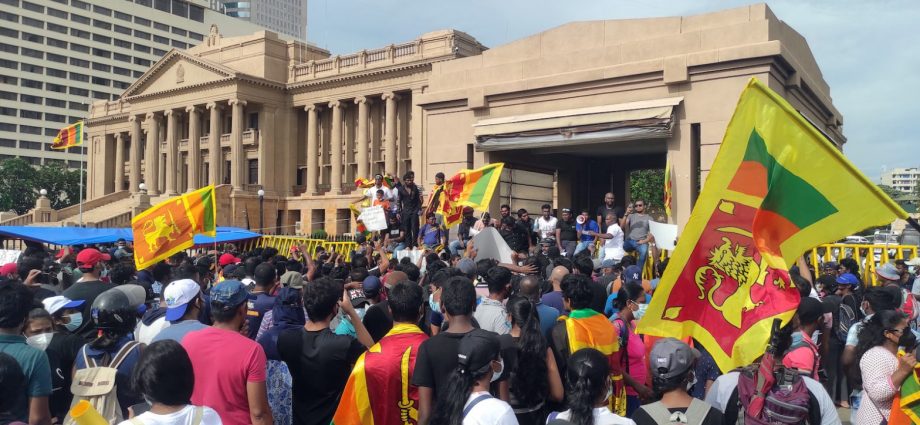
Tracing the origins of the disastrous agricultural policy that was one of the factors that led to Gotabaya Rajapaksa’s ouster as president and downfall of the Sri Lankan economy, we can see his dynamism being displayed when he promised a “revolution” in fertilizer use in his election manifesto. But the fact is that this was supposed to have happened over a 10-year span, not overnight.
In April 2021, the Sri Lankan president announced that the import of synthetic fertilizers was banned and no more would be procured once the stocks ran out. Rajapaksa stated that the synthetic agricultural inputs were causing “adverse health and environmental impacts.”
The main driver behind this decision was the hope that it would save the nation the approximately US$400 million it had been spending annually to import synthetic fertilizers and pesticides over the last few years.
After the ban, farmers in Sri Lanka could not afford the cost of organic farming, and the yield was much lower than expected. The production of rice fell by 20% in the next six months. Sri Lanka lost its self-sufficiency in rice production and had to import it from other countries.
The situation became so bad that Sri Lanka had to resort to importing 60,000 tons of substandard rice from countries that use harmful chemicals such as monocrotophos and glyphosate for paddy cultivation.
The fuel shortage in Sri Lanka also affected the transportation of paddy. The farmers who survived all this and successfully harvested rice were met with a new surprise. The government had authorized import of cheap rice that pushed down the market price of paddy in the nation, which meant the farmers could not sell their produce at sustainable prices.
The Food and Agricultural Organization of the United Nations stated in its Crop and Food Security Assessment Mission report that rice production in Sri Lanka would hit its lowest point after the drought in 2017, seeing a 42% decline year on year. The 6.2 million people (28% of the population) who are already suffering from food insecurity are set to face more problems.
Only 42.2% of the cereals required for the population were imported in the first six months of 2022 and the FAO believes that the country will not be able to meet its food-import requirements this year. The acute decline in production of export-oriented crops such as tea, rubber, coconut and spices has resulted in a reduction in household income as well as in revenues from exports.
Combined with this, the food inflation rate ballooned to 94% this August. This situation has forced the people to adopt coping strategies such as reducing the number of meals eaten in a day, altering portion sizes, dipping into their savings to purchase food, and borrowing money to purchase food.
Sustainable development
The Sri Lankan experience offers some insights in the area of developmental policies. When we look at this case in terms of the UN Sustainable Development Goals framework, we see that when the Sri Lankan government tried to advance UN SDG 13 (Climate Action) through an abrupt overnight move, it negatively affected SDG 8 (Decent Work and Economic Growth) to the point that the entire economy is in crisis now.
The SDG Framework has some flaws that prevent targeted policy action from being implemented and hinders forecasting the outcome of these actions.
The second lesson is that sustainable development cannot be achieved if developmental policies are not appropriately analyzed in tandem with available resources. Lifting successful policies from the developed nations and planting them in developing nations without tweaking them according to the local requirements will lead to counterproductive results, as we have seen in Sri Lanka.
For instance, this abrupt shift to organic farming could have been implemented without any trouble in a developed nation, since the rich countries have the necessary infrastructure, knowledge and skilled workforce. But when it was done in Sri Lanka, which lacked adequate infrastructure and had scanty production of agrochemicals, it had a detrimental effect on the domestic economy.
Sri Lanka tried to do a course correction in November 2021 by lifting the ban after huge protests from farmers’ organizations. The administration imported both rice and fertilizers using credit lines from friendly neighbors. The government also announced a compensation program for farmers, which would widen the budget deficit even more.
But it was too late, as the damage done to domestic production had become irreversible by then. Immediately after this, Sri Lanka asked India to deliver urgently 100 metric tons of nano nitrogen liquid fertilizers, which was accepted by India. India also extended a $55 million credit line to Sri Lanka for it to import urea fertilizer for the “Yala” cultivation season, which is effective during the monsoon period from May to end-August every year.
The government is currently looking to reduce rice imports because of the market-price problem discussed above. Sri Lanka also plans to infuse funds into its Paddy Marketing Board, which has assured farmers that it will procure rice from them at a floor price of 120 Sri Lankan rupees (33 US cents) per kilogram.
The key takeaway from the Sri Lankan organic-farming debacle is that it provides valuable lessons to other South Asian countries on implementing developmental policies in a contextualized manner rather than using a one-size-fits-all approach.
These policies can ravage the agriculture sector if they are implemented without the necessary knowledge and technical resources in place and if the people employed in the sector are not given proper training and support to enable a smooth transition.
In the case of Sri Lanka, the failed policy had a cascading effect that brought down the entire economy.
The author acknowledges Aravind J Nampoothiry at the National Law School of India University in Bangalore for his research assistance on this article.

